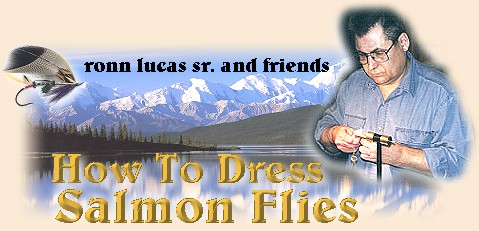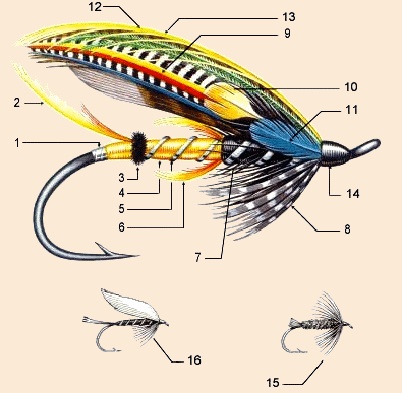1. Tag: The rearmost part on the fly and, the first
to be tied in. Tags usually consist of tinsel and floss on
Atlantic Salmon flies. Other materials might be yarn, dubbing
or, left off entirely.
2. Tail: The next element to be tied in on the Atlantics
or, the first on other patterns. Tails can be just about any
material either feathers or fur. On the Atlantics, the
predominant tail is a crest feather (topping) of the Golden
Pheasant. There are often veilings associated with tails.
3. Butt: This element is usually of Ostrich herl on
the Atlantics but, can also be Peacock herl in some patterns.
4. Body: Here, only the available materials limit
those used. Typically, on the Atlantics, bodies consist of
floss, tinsel, fur. The body can also be broken up into
segments and divided by body joints usually of Ostrich
or herl. Bodies on other types of flies are equally diverse
and, may be of differing sections which may or may not be
divided by body joints.
5. Ribbing: Tinsel is the most common material
used for ribs but, a contrasting color of thread or floss
may also be used.
6. Veilings: These are usually feathers but,
any material can be employed. They are set above, below or,
along side another element such as the tail or a body segment.
7. Hackle: When talking about Salmon flies,
hackle refers to a feather that is palmered over all or
a portion of a fly's body. Hackles are generally used in
conjunction with oval or round tinsel behind which it
follows to protect the hackle.
8. Throat: A throat or, beard are usually at
the front of the fly, under the shank. I sometimes use
the terms interchangeably but, in fact, there is a slight
difference at least to me. A throat has barbs of the feather
along the side of the hook shank that are pulled down and,
also some below the shank. A beard is generally only on the
bottom. A small distinction really. There are also different
methods employed to make these elements.
9. Wing: Boy, do we ever have options on this term!
Some flies have wings of hair while others are of feathers. If
that weren't enough, we now have synthetics to use. The
classic fully dressed flies used whole feathers, married
wings of strips of different feathers, at times, hair or,
combinations of these materials. Wings can be a single
element or, made up literally of dozens of elements
depending on the patterns. Modern fishing flies will
typically be simpler affairs but, the classic full
dressed flies are generally very complex and mix many
dissimilar feathers or, other materials. Wings may have
more than one structural component as well. These are
called underwings which are used to support the main
wing, outer wings which are on the outside of the main
wing and/or upper wings or roofs which sit on top of
the main wing.
10. Side: These are elements that are on the
front sides of the main wings which in the Atlantics can
be of the black barred Woodduck and strips of Teal. They
can also be the familiar Jungle Cock feathers which are
referred to as JC in the recipes.
11. Cheek: These are usually on the classics
as well and, are typically smallish feathers that were
traditionally Indian Crow or Chatterer which are
prohibitively expensive for all but the display flies.
Fortunately there are substitutes.
12. Topping: This refers to the crest feathers
of the Golden Pheasant (GP) which are tied in to conform to and,
frame the wing upper surface. Ideally, most patterns look
best when the tail, the wing and, the topping meet at the
same spot. Sometimes this just isn't possible so, don't
sweat it. The term topping can also be used for the tail
if a GP crest feather is used. It will of course, be
describing a wholly different part of the fly. Tyers
generally just call the GP crests, toppings. The term
is described by it's place in the pattern's recipe.
13. Horns: Except for the head, the horns
are the last element to be attached to the fly. Horns
were traditionally of Macaw tail feather barbs. The Blue and
Gold Macaw (blue and yellow barbs), Scarlet Macaw (red barbs)
and, Green Wing Macaw (Blue and red barbs) are a few of the
more common of the Macaws that are used. I have even dyed the
Blue and Gold Macaw tail feathers yellow which yields a wonderful
green and yellow feather that you will see later in the series.
I tried other colors with less desirable results and, since
Macaw feathers are fairly scarce and, expensive, we don't want
to waste too many to experiments that don't turn out well.
You will like the yellow dyed Blue and Gold feathers.
14. Head: Of course, the front end of any fly and,
the last element to be executed. Generally it is just made of
thread and cement but, some Atlantics also use a bit of herl
or dubbing right before the thread is tied off.
15. Collar: Typically a soft hackle tied at the
front of a fly without being pulled down like a beard or
throat.
16. Beard: A hackle usually tied on the bottom
of the fly only although, some Tyers use the terms, beard
and throat interchangeably.
~ Ronn Lucas, Sr.



